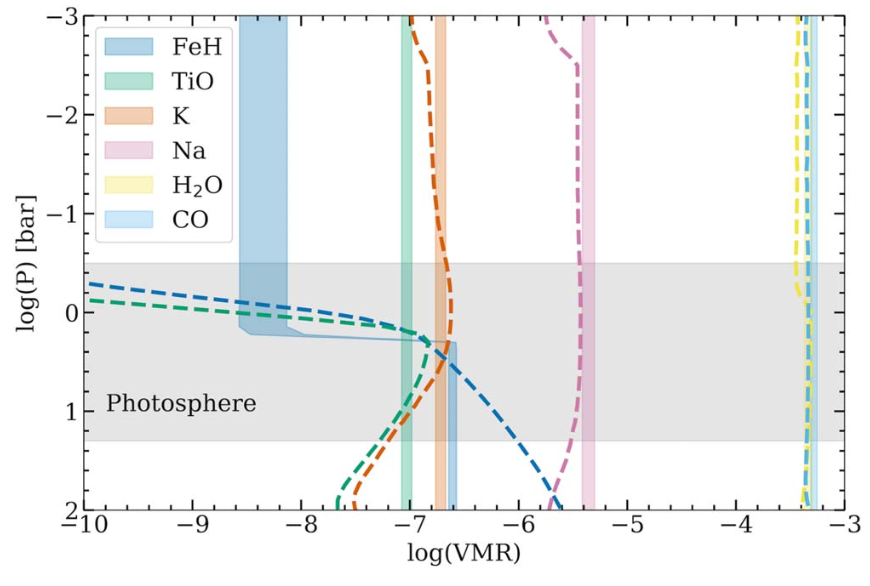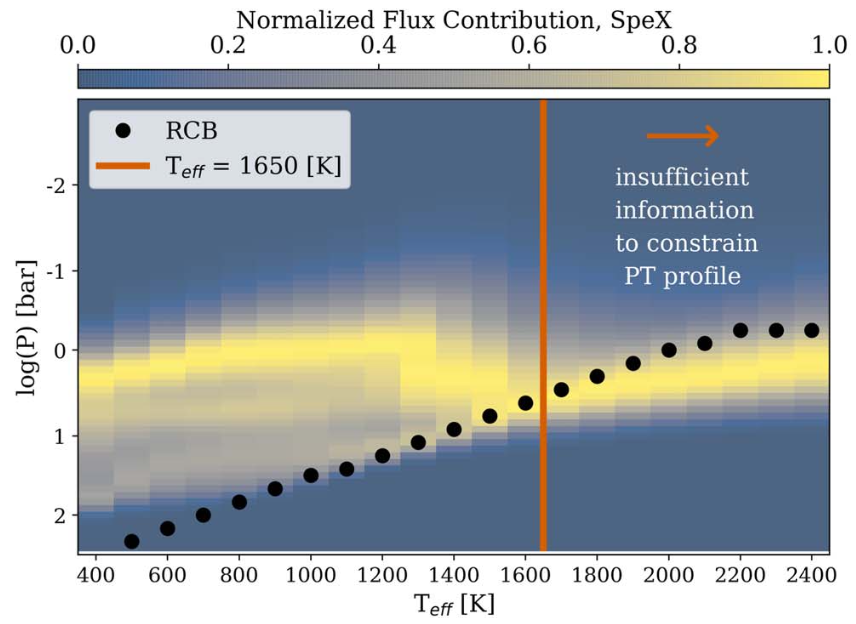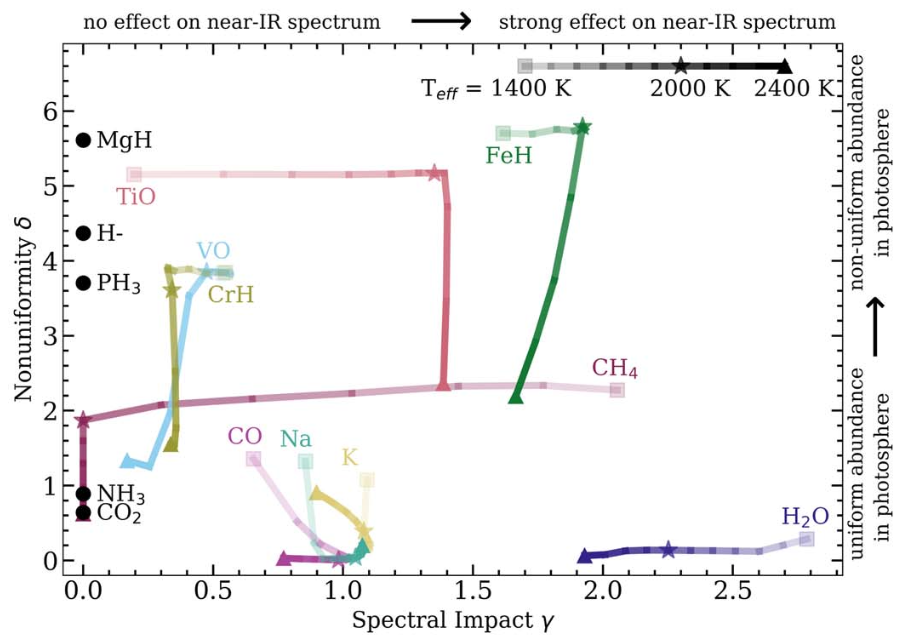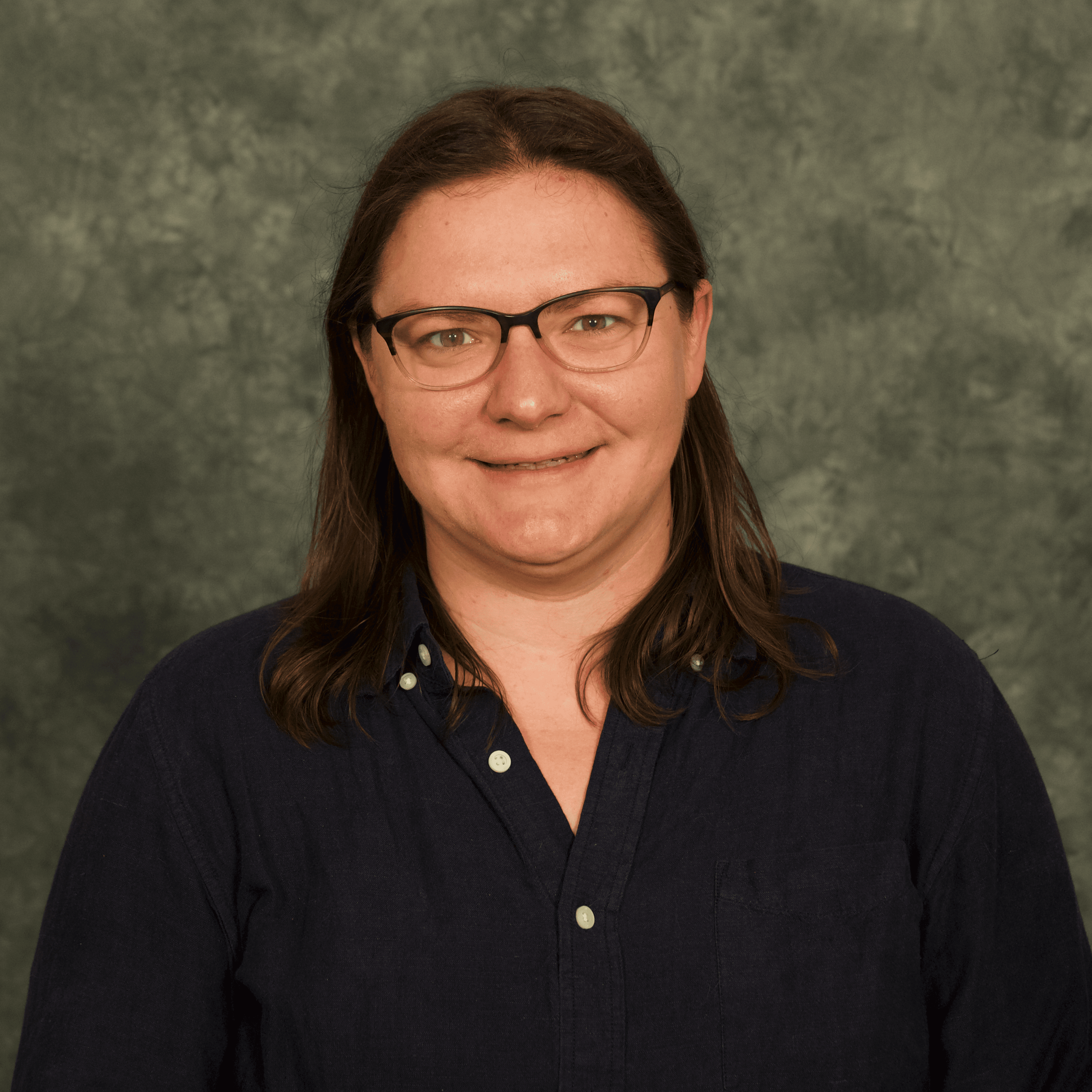Toward Robust Atmospheric Retrieval on Cloudy L Dwarfs: the Impact of Thermal and Abundance Profile Assumptions
In Rowland et al. 2023 (published in The Astrophysical Journal), we performed a suite of retrievals on self-consistent synthetic Sonora Bobcat spectra to show how different pressure-temperature profile parameterizations and uniform-with-pressure chemical abundance profiles can bias retrieved parameters. We developed a non-uniform abundance profile parameterization and identify specific gases and effective temperatures where such a parameterization may be needed.
 We show our retrieved abundance profiles (shaded) versus the "ground-truth" abundance profiles (dashed) from the Sonora Bobcat grid. Our non-uniform iron hydride (FeH) abundance profile traces the ground truth profile.
We show our retrieved abundance profiles (shaded) versus the "ground-truth" abundance profiles (dashed) from the Sonora Bobcat grid. Our non-uniform iron hydride (FeH) abundance profile traces the ground truth profile.
 This plot shows the SpeX (low resoltuion 1-2.5 micron) photosphere for objects of different effective temperatures. The dots indicate the radiative-convective boundary based on Sonora Bobcat models. If observations are not senstive to pressures below the radiative-convective boundary, smoothed P(T) profiles and parameterized P(T) profiles will produce unreliabe P(T) profile results.
This plot shows the SpeX (low resoltuion 1-2.5 micron) photosphere for objects of different effective temperatures. The dots indicate the radiative-convective boundary based on Sonora Bobcat models. If observations are not senstive to pressures below the radiative-convective boundary, smoothed P(T) profiles and parameterized P(T) profiles will produce unreliabe P(T) profile results.
 Nonuniformity vs. spectral impact of 14 gases for L dwarfs. Color gradients indicate different effective temperatures. Gases in the upper right of each plot have high spectral impact and have highly nonuniform abundance profiles. Gases whose removal does not impact any data points in the spectrum above the noise are indicated with black circles. The stars indicate the values for the 2000 K object studied in this paper.
Nonuniformity vs. spectral impact of 14 gases for L dwarfs. Color gradients indicate different effective temperatures. Gases in the upper right of each plot have high spectral impact and have highly nonuniform abundance profiles. Gases whose removal does not impact any data points in the spectrum above the noise are indicated with black circles. The stars indicate the values for the 2000 K object studied in this paper. We show our retrieved abundance profiles (shaded) versus the "ground-truth" abundance profiles (dashed) from the Sonora Bobcat grid. Our non-uniform iron hydride (FeH) abundance profile traces the ground truth profile.
We show our retrieved abundance profiles (shaded) versus the "ground-truth" abundance profiles (dashed) from the Sonora Bobcat grid. Our non-uniform iron hydride (FeH) abundance profile traces the ground truth profile.  This plot shows the SpeX (low resoltuion 1-2.5 micron) photosphere for objects of different effective temperatures. The dots indicate the radiative-convective boundary based on Sonora Bobcat models. If observations are not senstive to pressures below the radiative-convective boundary, smoothed P(T) profiles and parameterized P(T) profiles will produce unreliabe P(T) profile results.
This plot shows the SpeX (low resoltuion 1-2.5 micron) photosphere for objects of different effective temperatures. The dots indicate the radiative-convective boundary based on Sonora Bobcat models. If observations are not senstive to pressures below the radiative-convective boundary, smoothed P(T) profiles and parameterized P(T) profiles will produce unreliabe P(T) profile results.  Nonuniformity vs. spectral impact of 14 gases for L dwarfs. Color gradients indicate different effective temperatures. Gases in the upper right of each plot have high spectral impact and have highly nonuniform abundance profiles. Gases whose removal does not impact any data points in the spectrum above the noise are indicated with black circles. The stars indicate the values for the 2000 K object studied in this paper.
Nonuniformity vs. spectral impact of 14 gases for L dwarfs. Color gradients indicate different effective temperatures. Gases in the upper right of each plot have high spectral impact and have highly nonuniform abundance profiles. Gases whose removal does not impact any data points in the spectrum above the noise are indicated with black circles. The stars indicate the values for the 2000 K object studied in this paper.